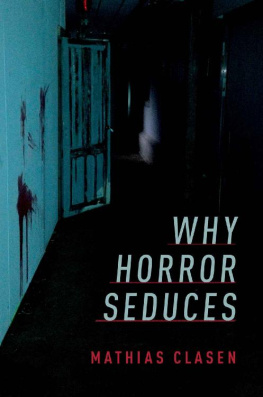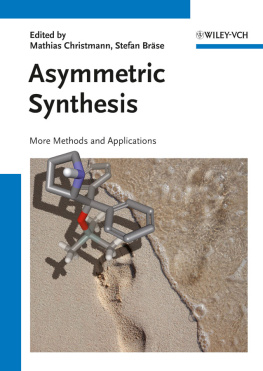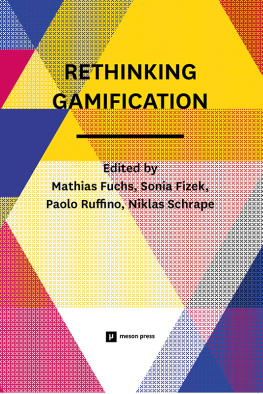Acknowledgements
An important part of this book has been written when I had the privilege to be a Senior Fellow of MECS in Lneburg. MECS is an Institute for Advanced Study on Media Cultures of Computer Simulation funded by the German Research Foundation (DFG) at Leuphana University Lneburg. It became apparent during the time of my fellowship that computer simulation and computer games have a lot in common and I owe inspiration about the epistemological basis of large-scale simulations to the MECS directors Claus Pias and Martin Warnke. Together with the other fellows we had ample opportunities to discuss which problems and knowledge constellations can be addressed via computer simulation, which new forms of knowledge it generates and to what extent it represents a historical break.
I also would like to thank my colleagues from the Institute of Culture and Aesthetics of Digital Media (ICAM) for their critical and supportive comments on my ideas. The psychoanalytical section in this book would not have been possible without the intellectual input from the research network Affect- and psychotechnology studies emergent technologies of (self-) control mechanisms on the affect and emotions level. Marie-Luise Angerer from the University of Potsdam has been directing this network and was a source of inspiration and support. Markus Rautzenberg helped me from the very beginning of this publication project with his profound knowledge about philosophy and games and his friendly patience in discussing complicated matters. Chris Bateman opened my eyes to many aspects of the games industry and to the history and philosophy of video games. Ernst Strouhal from the University of Applied Arts in Vienna has long since been a mentor and friend whom I learned a lot from: theory of board games, magic tricks, chess and good food.
A heartfelt thank you to my editors and proofreaders at Bloomsbury for working so efficiently and stressfree in the planning and production phases.
Finally, my sons Renzo (11) and Noam (7) showed me games that I would not have looked at on my own. It is due to their enthusiasm about Wii games and smartphone apps like the fabulous Mekorama (2016) that I learned to appreciate unsophisticated visuals and saw that gaming joy is not a matter of high-end pseudorealistic graphic engines.
Introduction:
Phantasmal Spaces
Everyone I know has seen the clouds in the sky.
Many people have traversed a forest.
Some have jumped from a cliff.
Most of the people I know have been in a cave.
And almost everyone has been on an island and travelled on a road.
All these people share an experience of space that is strongly anchored in the spatial disposition of a venue, a passage or a site and embraced by the poetics of these spaces. As much as the venues are topological containers for an individual to be situated within, they are also poetic machines that could be viewed with the eyes of a psychologist, a psychoanalyst, a philosopher or an artist. This book is written with the intention to obtain alternating points of view. Gaston Bachelard found a fitting notion for such a diversity of methods, when it comes to an analysis of space. He suggested that the radiation of the poetic images that surround spatial archetypes should undergo some form of topo-analysis (Bachelard [1957] 1964: xxiv). Obviously alluding to psycho analysis Bachelards topo-analysis is more than a Freudian view on a topos. Bachelard acknowledges the relevance of the psychologists viewpoint and the psychoanalysts method, but he suggests that phenomenology introduces a new quality of resonating with the investigated spatial object. This resonance leads to a form of understanding that goes beyond knowledge. Knowing must be accompanied by an equal capacity to forget knowing. Non-knowing is not a form of ignorance but a difficult transcendence of knowledge (Bachelard [1957] 1964: xxviiixxix). For Bachelard topo-analysis is the method of his choice to step from knowledge about the space to a form of intimacy with space. The philosopher states that he would not describe objectively geometrical and physical problems and that he would even go beyond the limitations of memory. My research, he states, is devoted to the domain of intimacy, to the domain in which psychic weight is dominant (Bachelard [1957] 1964: 12).
The intention of this book is to deconstruct some of the clichs we have much too willingly accepted when dealing with archetypical spaces. I do not want to get rid of knowledge about spatial archetypes or to disconnect from the history of poetic, scientific or technological reasoning about space. On the contrary, I intend to relate observations from art history with innovations for computer games technology and to create cross-references between findings from psychology and psychoanalysis with claims from media studies. The network of references suggested here is supposed to install a precise view on crucial details of the whole. With no attempt to cover the totality of spatial archetypes the method of a topo-analysis that is based upon a multimodal approach hopes to provide a glimpse or even a close view on spaces of intimacy. All the spaces of intimacy are designated by an attraction. Their being is well-being. In these conditions, topoanalysis bears the stamp of a topophilia, and shelters and rooms will be studied in the sense of this valorization (Bachelard [1957] 1964: 12). A topophile project like this book is certainly subjective and the reason for selecting spatial archetypes like the ruin, the cave, the forest and the road amongst others can hardly be defended other than by stating bluntly: I detect a particular radiation that these spaces emit that is intense, lasting and rich in connotations. Other authors might have selected different spaces and actually this book could be substantially extended by adding further spatial archetypes, e.g. the ocean, the moon, the desert or many more. I hope, however, that many readers will sense a sonority that they have experienced as private and remote voices. The book shall also help in discovering that many of the private voices and radiations are not as private as we think they are. There are certainly spatial dispositives that are related to archetypes that C. G. Jung wants to trace back to what he calls collective subconscious. Bachelard warns from subscribing to the psychologists obsession of getting lost in the inextricable chaos of psychological antecedents and uses C. G. Jungs own words here (Bachelard [1957] 1964: xxviii) but he differs from Jung, when he states that we must go beyond the problem of description whether this description be objective or subjective, that is, whether it gives facts or impressions (Bachelard [1957] 1964: 4). The psychoanalysts method of making the unconscious conscious diverts the observer from seizing the specific reality of a spatial arrangement. Bachelard admits that the approach of the psychologist, the psychoanalyst and the phenomenologist all contribute to an understanding of the object of inquiry, but it is the under in understanding that he is suspicious of. For the psychoanalyst sublimation is nothing but a vertical compensation, a flight upwards, exactly in the same way that compensation is a lateral flight. And right away, the psychoanalyst will abandon ontological investigation of the image to dig into the past of man (Bachelard [1957] 1964: xxvi). In other words, the psychoanalyst cannot appreciate what is, but needs to see what lies underneath. Bob Dylan phrased the attempt to free ones mind from what lies underneath immediate sensory perception in his song Gates of Eden when he says:














